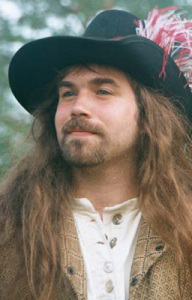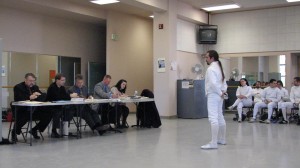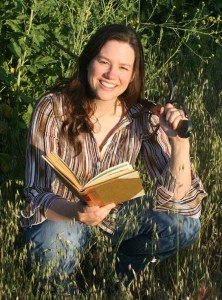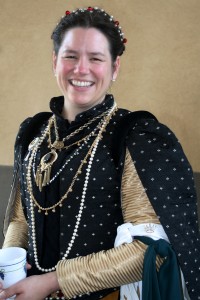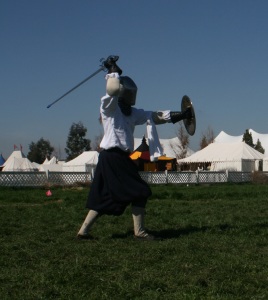An Open Letter to the SCA’s Board of Directors…
My name is R. E. “Puck” Curtis III and I have been participating in the SCA for over 20 years as a fencer. Inside the SCA I am known as don Pachomius Oneshoe (or Puck).
Outside of the SCA I was the first White Scarf to certify as a classical Italian fencing master under the program founded by Maestro William Gaugler.
As such, I find myself in a strange position. My mundane self outranks my SCA persona.
I am a board certified Master at Arms entrusted with preserving an Italian martial art with a teacher-to-student lineage which dates back to the mid-1600s through the Scuola Magistrale Militare di Roma. I have taught fencing both within and without the SCA. In addition, I travel both inside and outside the United States to train and to teach European sword arts specializing in the historical Iberian traditions.
My wife and partner in these efforts is Dr. Mary Curtis. She is a Fulbright scholar and holds a PhD in Golden Age Spanish literature with a focus on the historical sword arts of the period. Dr. Curtis is also a White Scarf of the Kingdom of the West and she lived in Spain for a year combing through archives to research historical fencing.
It is with some reluctance that I admit I may be an SCA fencer of some note, but I also assert that were it not for the SCA I never would have achieved these things. In that sense, my accomplishments are a reflection of the Society itself and what is possible when a young man or woman is given a good start in the world.
Perhaps it seems obvious what events have led us to this crisis of leadership in the Society. You will be receiving a slew of angry letters. I am not interested in assigning blame but instead in finding solutions. I shall suggest a different cause for our troubles and in so doing perhaps bring some hope and light into the conversation.
The problem is fidelity.
It is fellowship.
It is our love for those who excel and do wondrous things.
There is a lack of equity in the awards structure but the love that people hold for each other remains the same. When a king or a queen sees a subject shine like a beacon their need to serve the subject stumbles because their hands are tied. This has put the SCA under increasing social pressure as it tries to balance an outstanding (but diminishing) prejudice against fencing with a desire to recognize people of value in a fair way. That pressure has erupted in different ways.
Consider two different solutions to the building social pressure:
- Ansteorra’s White Scarves are peers in all but name. Their order mirrors the Cult of Elizabeth and it is deeply embedded in the kingdom’s psyche. The relationship between their White Scarves and the queen is a cherished part of the national identity.
- Other kingdoms like An Tir have resolved the problem by making rapier Laurels. These Laurels have to meet a Laurel’s requirements for period fencing research and practice to join their order.
The board’s recently proposed solution was to steer the fencers into the Chivalry based primarily on fighting prowess. By stumbling out of the gate with a surprise decision the board has created a conflict between the Chivalry and the rapier community. That conflict has fanned old fiery tensions which had largely cooled into bonds of fellowship. Now, tempers are rising on both sides.
And what of our knights?
The Chivalry represents a pool of potential governance sworn into fealty. From the Chivalry typically arise the kings and queens of the Society. The responsibilities of rulership are not insignificant and are completely beyond the scope of the fencing community. I can see value in protecting a private space which allows the Chivalry to hash out difficult subjects and provide a unified presence. (I say this as an outsider having never participated in a chivalric circle.)
As a fencer, I should also confess that I never dreamed of the title of “Sir.” Nor did I imagine that someday I might take squires. These are not fencers’ dreams. A fencer’s dream is to be a Maestro d’Armi (Master at Arms). When the SCA could not help me realize this goal, I went out into the mundane world and did the work required to make that dream a reality.
Therein lies your solution. My understanding is that the order of the Master at Arms was created to solve a similar problem. The SCA had created some bright shining stars of martial prowess and grace on the rattan field. There was a social pressure to recognize these peers for what they were but, for religious reasons, these fighters could not swear oaths of fealty. These individuals had qualities so great that a solution was proposed and the Masters at Arms were created.
This peerage can again resolve the social pressure to recognize gifted people if we but accept that a Master at Arms can be skilled with a variety of weapons. Their order is a natural fit for martial arts beyond the scope of romantic chivalry. That might be rattan, fencing, mounted combat, archery, or thrown weapons. All of these things are obviously martial arts worthy of recognition and the Masters at Arms will be the least impacted peerage in the Society.
I urge you to preserve the Chivalry’s space in which they govern. Knights must swear their oaths and the burden they carry is unique. Respect that. Instead, open the peerage of the Masters at Arms to those who wield diverse arms and the problem is solved in a lasting and meaningful way. By creating a firewall between the Master at Arms and the Chivalry the unsworn peerage is allowed greater function without sacrificing historical correctness. If the Chivalry wish to retain the currently existing Masters at Arms in their circle they have only to extend an invitation. (Inviting others into their space for counsel is their privilege.)
What of the White Scarves then?
The original White Scarf iconography was inspired by a white sash worn as a baldric indicating military command. (Cyrano de Bergerac contains a notable example when he recovers De Guiche’s sash of command from the battlefield at great personal risk.) Since wearing a white scarf as a baldric conflicted with the white baldric worn by the Masters at Arms, White Scarves instead wore a scarf as a lady’s favor, and this emblem of rank has become the queen’s favor.
Imagine reuniting the White Scarf with its origin as the baldric of command in a peerage ceremony. I ask you to cast your eye forward to see this moment realized.
A member of the Order of the White Scarf is brought before the king and queen. At her arm is tied the white scarf indicating the queen’s favor but on this evening she wears two scarves; one long and one short.
“Will you become our master and teach your art to the people of this kingdom?”
“I will,” she replies.
In the torchlight the longer scarf is then tied crosswise across her body to form a master’s baldric and a Maestra d’Armi is created.
To open a school of fencing. To be a master. To serve the kingdom. These are the dreams of a fencer and now more than any time in our Society’s history this dream is possible.
I say this to you as a classical fencing master myself. I say it to you as a White Scarf of the Society. I say this to you as a person who understands the love and fidelity of our Society. Allow the Master at Arms to again be the solution which binds us closer together in love, fellowship, and fidelity.
In brief summary,
- We arrived at this place because of our fidelity.
- Create a firewall between the Order of the Chivalry and the Masters at Arms.
- Open the order of the Master at Arms to diverse arts.
- Assert that the Chivalry can invite a Master at Arms into council as they see fit.
With respect and gratitude for your service,
R. E. “Puck” Curtis III
Master at Arms, San Jose Fencing Master’s Program
Known in the Society as
Don Pachomius Oneshoe
Member of the Order of the White Scarf of Ansteorra


